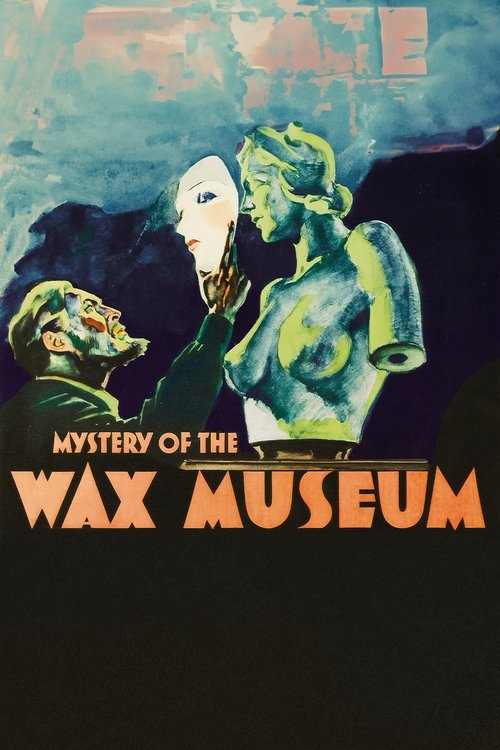Ivan Eigor is an artist who works in wax. Unlike most wax museums, his subjects are historical or artistic. Joan of Arc at the stake is about as gruesome as he gets; his Marie Antoinette a cheerful young queen instead of facing a guillotine. He even works in more romantic subjects. One of his exhibits is a young woman holding a baby, a tribute to motherhood.
While his artistic skill has drawn the attention of critics — “You have no right to hide such genius in a side-street museum,” cries a visitor — the lack of gruesome spectacle drives his business partner Joe Worth batty. Worth proposes to offload the shop and recoup some losses through arson, but Eigor — who refers to his sculptures as his “children,” is not enthusiastic. So Worth burns the museum down with him Eigor locked inside.

“Oh no, not again.”
Twelve years later, a new wax museum prepares to open. The sculptor is Eigor, and he’s recreated the masterpieces that are lost. Joan of Arc is a recent creation, coincidentally unveiled shortly after the suicide and corpse-theft of a young actress. Now he has his eyes on Charlotte (Fay Wray), who he thinks looks exactly like Marie Antoinette. Charlotte’s roommate — desperate but nervy reporter Florence (Glenda Farrell) — gets suspicious and starts poking around.
Watching pre-code films like this and The Thin Man will test your preconceptions about what old movies are. Sure, the fashions are strange and you have to tune your ear to the accents and the lingo — ninety years is a long time for language, especially slang — but this film is frank about sex, violence, and alcohol.
It even gets a few digs in at the cops that old Billy Hays would never have tolerated. Looking for corpses, Florence stumbles onto a cache of bootlegged whiskey. She grabs a few bottles in full view of the shocked police. “This is my percentage,” she says. “You guys are going to get yours. I found this dump.”

“Hello, sweetheart. How‘s your sex life?” ← Actual line.
You will have noticed that the stills here are in color. Mystery of the Wax Museum was shot in color using a two-color process. Depending on which restoration you are watching, this color might look awesome or it might look terrible. The version I watched was a standard-definition release included as an extra on my House of Wax disc, and the colors were certainly well off.
Mystery of the Wax Museum used Technicolor’s two-color process. Those two colors were red and green. The version I watched has a lot of blue and purple — which you can’t get out of red and green. So this version veers pretty heavily into “colorized” territory rather than being merely “restored.”
I supposed I can’t blame them too much, though. Two-color restoration work is no joke. This movie, like many of its era, was shot on celluloid nitrate film. Nitrate has a tendency to burst into flames so it has to be handled and stored carefully. And two-color films were made by shooting the same frame onto two different frames, dying the frames, then fusing those frames together with a solvent. That’s fine when the film is young, but old celluloid, like all of us, has a tendency to buckle and warp with age.

Nevertheless, Fay Wray’s impression of a wax statue of a French queen is excellent.
In fact, Mystery at the Wax Museum went pretty much unseen after its first release. Warner never showed it again in theaters. It was a lost film until the 1970s, when Jack Warner found it in his own collection. Many teams have tried since to restore the film, but it wasn’t until 2019 that anyone had any measure of success.
The best part of the movie is Glenda Farrell, the hard-drinking, fast-talking, super-nosey Florence. She upstages everyone. The romantic couple is boring. Ivan Eigor is creepy but prone to monologuing. Most of the men are useless. Florence pairs up with a rich kid who’s initially accused of the murder, but he turns out to be no use in a pinch.
Glenda was in ten movies and a short in 1933. At one time, she was filming five movies at once. This and the gang classic Little Caesar (1992) might be the only movies she’s in available in high-quality restorations.

Glenda, you’re killin’ ’em out there!
Sadly, Florence does not reappear in either of the House of Wax remakes. The hero role in both later versions is male. But Glenda would get to play a similar character seven more times as Lois Lane prototype Torchy Blaine, as well as being paired with Joan Blondell as the stars of five slapstick comedy movies.
Mystery of the Wax Museum would be remade twice as House of Wax, but also have the same plot reworked many more times in movies like Mill of the Stone Women, A Bucket of Blood, and Castle of the Living Dead. None of them quite live up to this fearless 1930s shocker. Weird blue tint notwithstanding.

